Simplified guide of the Castle of Valbona
External
Welcome to Valbona
More than a castle with its court, this is a fort
capable of hosting a garrison of ten or twelve armed men: four knights, eight
foot soldiers with a captain and a certain number of "families" (servants) for
the normal functioning of the structure. A fort is always located to guard a
strategic place and depends on a castle, in our case that of Lozzo, now transformed
into Villa Lando Correr.
The excavations under the north-east tower have brought to light finds of late
Roman pottery which will be exhibited in the Sala Cavalieri in the near future.
Therefore built on previous settlements, it is mentioned as operational in the Capodilista
Code of 1258, although it was in those years that it was heavily remodeled and assumed its
current appearance, ready to play an important role in the struggles that were preparing
between the Scaligeri (Verona) and the Carraras (Padua), after the brutal raids of
Ezzelino III da Romano.
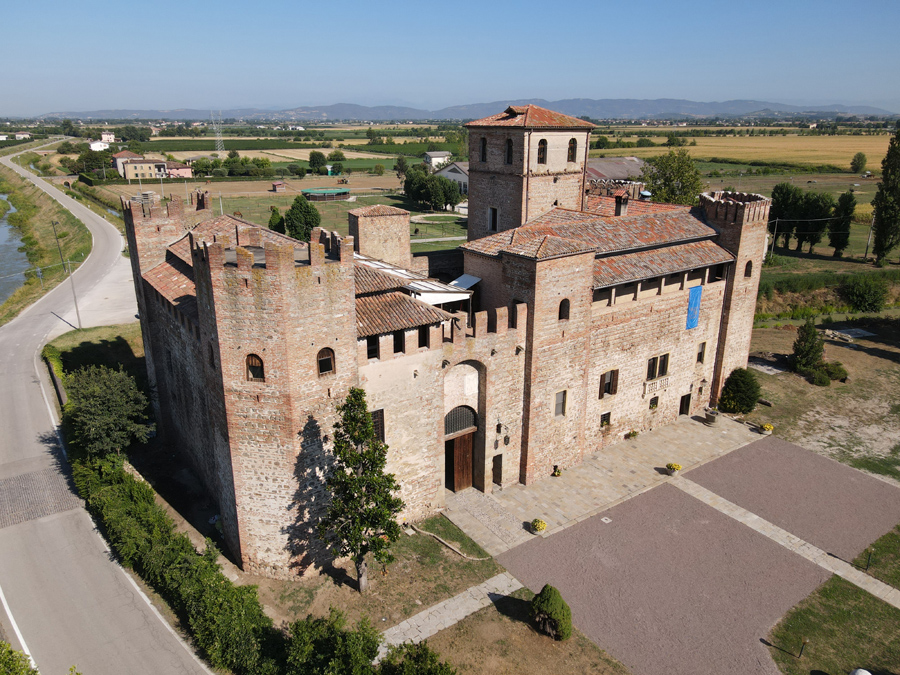
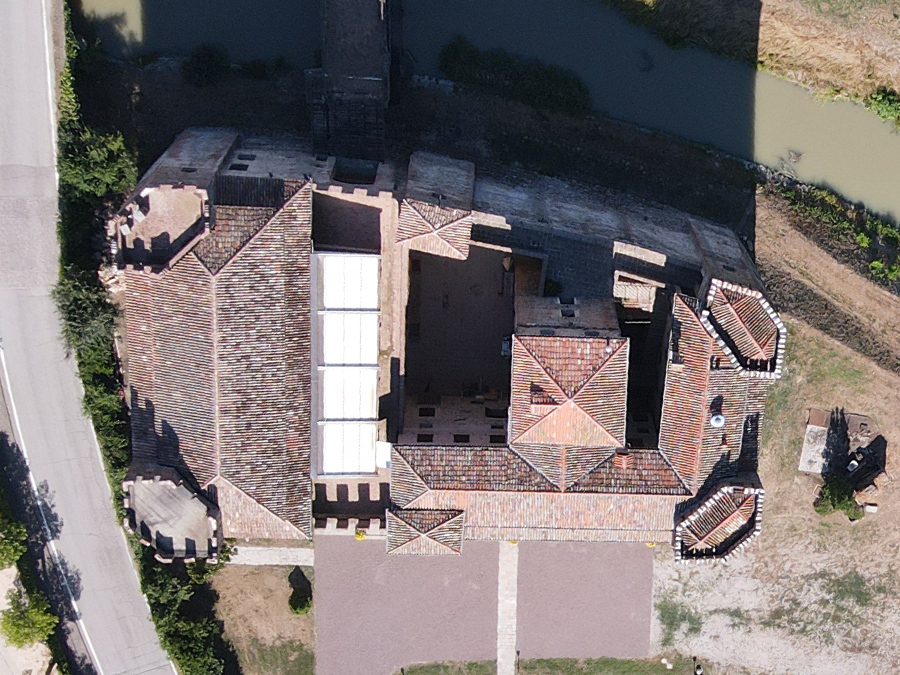
It has a trapezoidal shape, with sides measuring 25 x 40 x 9 meters. The walls have a height of 9 meters and a thickness of 1 meter at the base and 0.50 at the top. It is strengthened by six towers, four hexagonal at the corners and two square near the two main gates. All the towers are 11 meters high and in the center stands the keep which is just over 22 meters high.
Tests of the building material conducted by the University of Padua confirmed that the building dates back to the 13th century.
Note the hexagonal shape of the corner towers, very rare because it is expensive, but which significantly strengthens the structure, smoothing out the blows and allowing defense from several sides.
Note the two iron rings above each window with an all-round arch: these are the hinges of wooden doors which were opened as in a gunboat vessel to shoot arrows, throw other projectiles and then be closed quickly by the same force of severity.
Observe the trachyte gutters above the large doors: suitably angled, they were used to pour boiling oil on the assailants
which, with the high speed wind, oxygenated and caught fire. In response, of the stone balls that we see in the park,
the small ones were hurled with a catapult, while the large ones were hoisted onto a rail made up of two logs about a
hundred meters away, then the rail was inclined towards the manor to allow the rolling of the large stone to break the door.
We cross the door and enter.
Old Customhouse
It is a long corridor with two large doors at the ends and, alongside, two smaller doors for pedestrians. On the side walls there are two openings, one towards the weapons room, the other leading to the internal courtyard.
As you can imagine, the road that today deviates once crossed the manor and precisely this environment that maintains the pavement for vehicles and pedestrians in the floor, for which all wayfarers were forced to pass through here, to be controlled and, possibly, taxed on what they brought with them: there were no other roads in this marshy area, whose last reclamations date back to 1920.
Note the lanes of large metal grates immediately after the gates.
Look at the pedestrian doors: they are on the opposite side of each other. In this way, those who forced the block could not run close to the wall, but had to cross and expose themselves to the shots of the archers who were on the walkways above us. In fact, we must imagine this room as an open space and the cloths with the family colors (gold on blue) today hide a ceiling with infill in poor quality material, made in an unspecified period.
Beyond the gates, on the west side, there are still two drawbridges, one for vehicles and one for pedestrians. It is probable that the manor was entirely surrounded by the moat, with double bridges also on the east side, but there is no historical evidence in this sense. Conversely, we know that the canal on the west side was dug in 1454 by Nicola, the first count, and in fact is still called "Canale Fracanzan" today, and was intended to drain all the marshy waters in the fiefdoms of the family, from Alonte , Orgiano, to Agugliaro, up to Este.
There is a project for the restoration of the bridges with the possibility of operating the mechanism by visitors.
The light-colored furniture that we see placed along the walls is intended to house the products of wine and olive-growing houses in the Euganean-Berico area.
The first door on the left of the customs leads to the The Sala delle Armi.
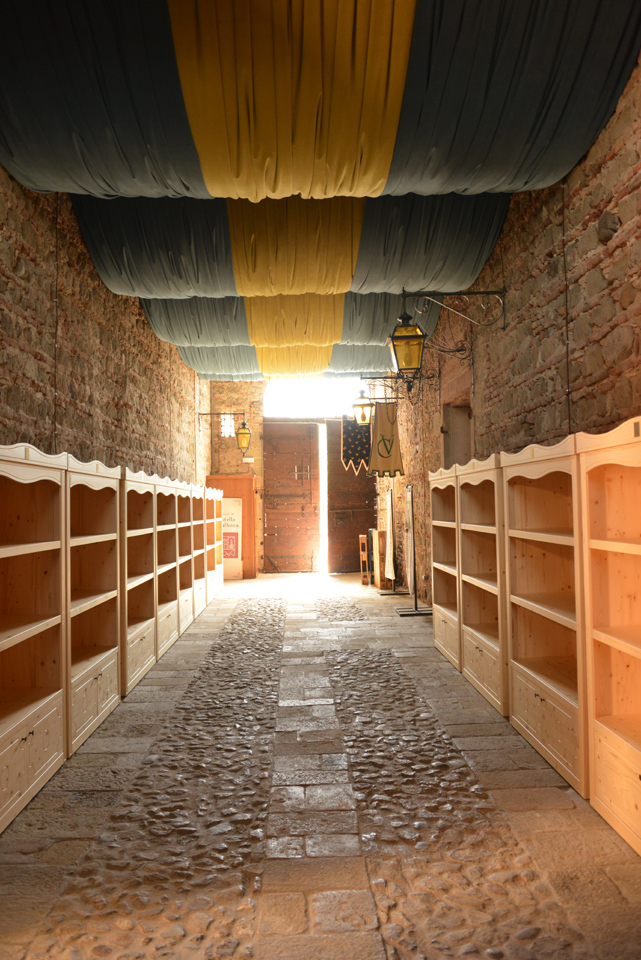
The Weapons Room
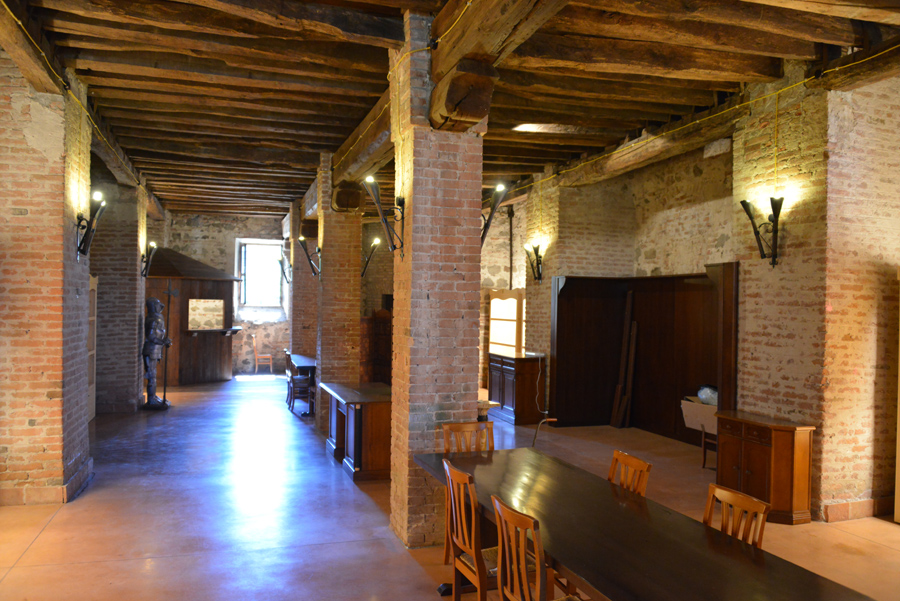
The Sala delle Armi was the stationing place for the troops, the care of weapons and shoeing, i.e. the actual military district. You had ready access to customs to intervene when necessary.
It is a very large environment and particularly protected by the mighty walls and towers that reinforce it, smoothing out the edges. Note the depth of the hollow of the towers, visible on the south-west one. To the right, near the beginning of the staircase, you can see a small "hut" apse, perhaps a lamp holder, perhaps the seat of a votive figure.
The staircase, originally a wooden ramp, leads to the Sala dei Cavalieri.
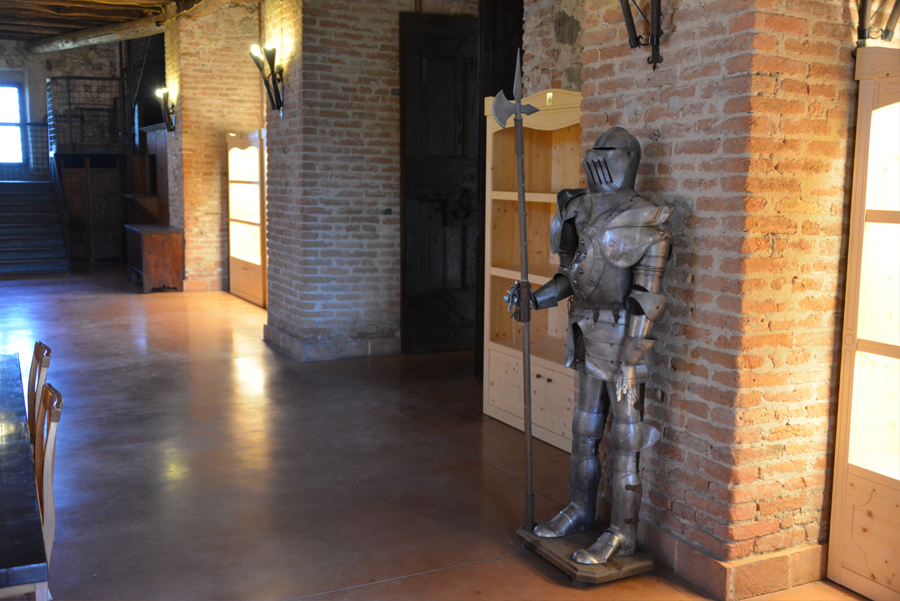
Knights Hall
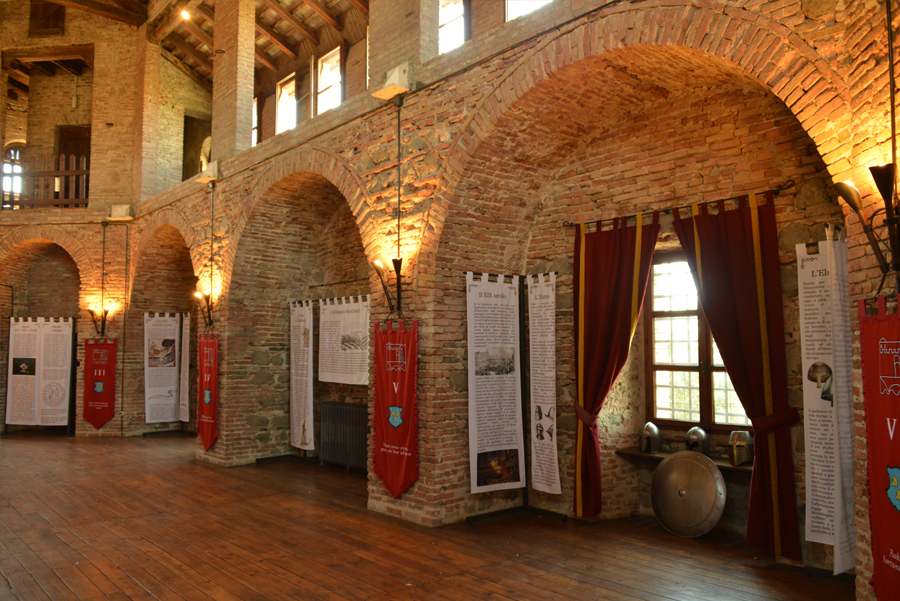
It is the largest room in the building, a place for banquets, meetings and the main activities.
It hosts an interactive exhibition entitled
From the force against the neighbor ,
to the force towards the territory for a healthy and cultivable environment.
created by
Download the Mirantibus application with the qr code and follow the exhibition which contains three itineraries: on the territory and food,
on weapons and, then, one dedicated to children on characters linked to the castle.
Weapons can be tried on, helmets and armor can be worn, also to test the weight that can be reached with all or part of the equipment in battle.
Once the exhibition is over, we go down and go back to the old customs which we walk to the end, finding on the right a door that leads to the internal courtyard.
The internal courtyard
We are not on the ground level, but four meters above the canal: below us there are still two floors of rooms, mainly the waterways and drains which you can see on the west facade, looking at the trachyte gutters from the outside and guessing the height of this courtyard, considering that we are thirty centimeters above the base of the door and the drawbridge.
The courtyard contains the well, the only real well in the manor for the supply of drinking water.
In the west side arches, before the well, the animals found shelter: two cattle in the small one and four
horses in the larger one, with the manger hooked to the wall and a drainage channel for the manure on the back,
where today we see these red bricks placed in length.
Hay and fodder were sheltered under the shed and in the face near the well.
Nothing was attached to the keep, to prevent it from being set on fire in the event of an attack.
Hens and various poultry moved in the farmyard, now paved, while domestic papers also attest to the presence of sheep and goats.
Everything was functional to the maintenance of the garrison.
We pass under the residence through a vault to enter the second courtyard.
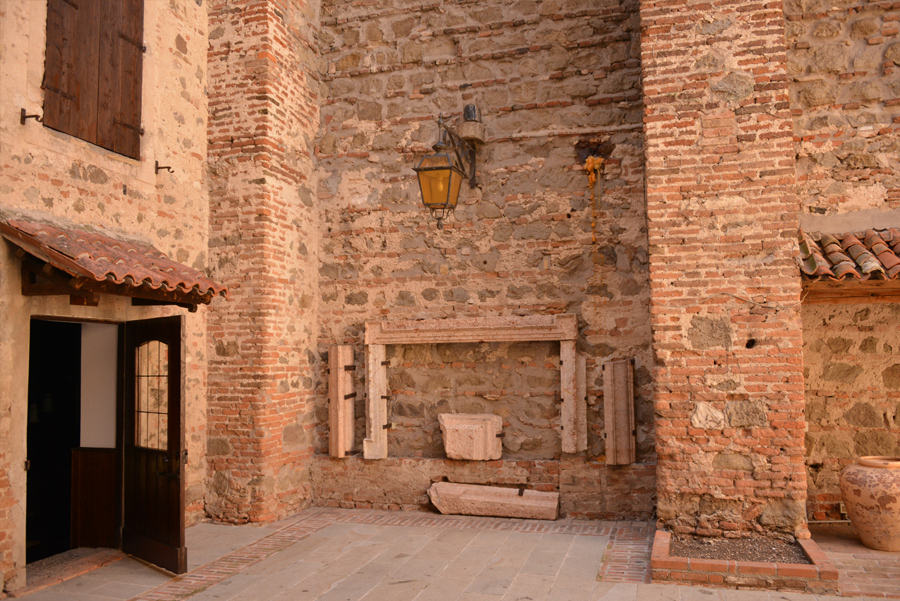
The ancient prisons
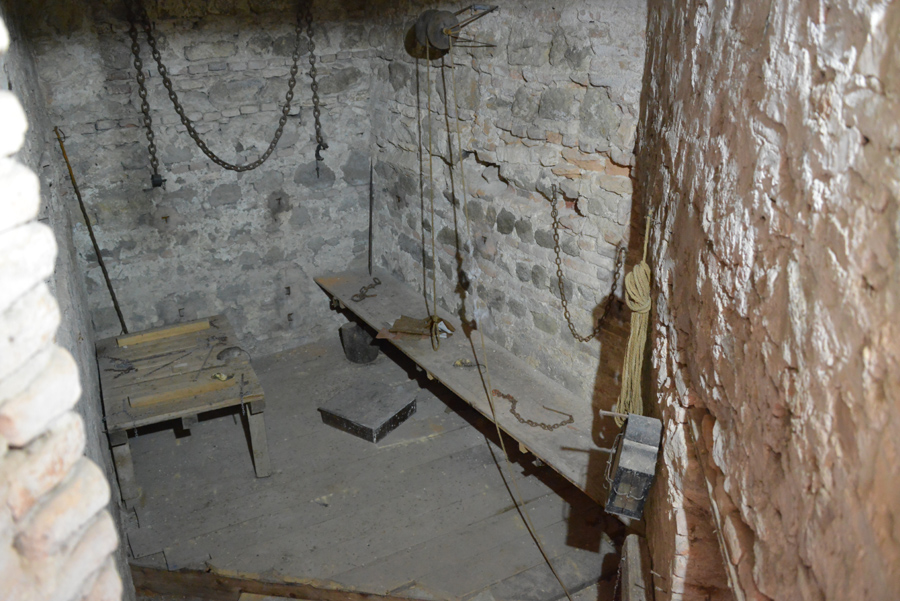
At the base of the northwest tower, in the coldest and bleakest part of the manor,
we can see the old prisons, with planks, chains and ropes. It is a recent
reconstruction, but very plausible. Both the domestic archive and the Liber foeudorum
of the Biblioteca Capitolare of Vicenza agree in mentioning the prisoners, the crimes
charged with them and also the capital sentences carried out in loco solito iustitiae,
according to a formula which is also found in the Castle of Strassoldo di Sotto, in Cervignano, in Friuli.
We do not know what the place mentioned was, but it cannot be excluded that it was in the prison,
but rather outside, in an external clearing, where it could be seen by the community, according to a general
preventive effect linked to the penalty. We know that the execution took place by cutting off the head
with an axe, while the sword was reserved for the nobles. Death sentences were no longer carried out in Valbona
after 1405, when the jurisdiction of higher crimes was taken away from the feudal lords or noble councils of the
cities to be attracted to the competence of the Serenissima Dominante, i.e. Venice.
We now go up the only stairs that connect the lower part to the upper one, we pass the family residence
(without entering it!) and we arrive at the stands.
The patrol path
So be careful when leaning on it.
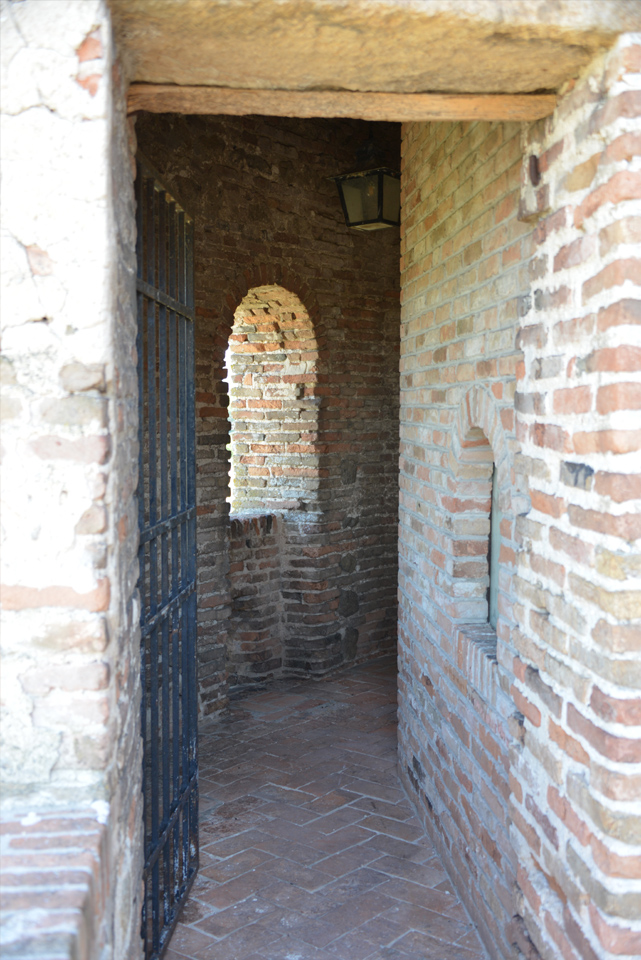
Climb the stairs, turn right and begin the patrol walk clockwise, entering the north-west tower, four floors above the prisons.
We can understand the power of the walls, made of stone and terracotta, to be robust and elastic at the same time, unlike German castles, where the impact on the stone propagates, is not cushioned by elastic material, but is transmitted throughout the building, weakening the structure. We note the arrangement of the bricks of the "gunboat" windows and the drainage for the water (there are no gutters, but only loopholes and drips. Continuing we see an ancient aedicule, where there was a fresco of San Giorgio and the dragon, covered and obliterated by a boiler whose pipes are being removed.The covered loggia continues past the corner with the north-east tower, then the square tower with its arched window and traces of stairway on the inner walls.
We turn right again to complete the route clockwise and we see the terrace that was not originally there, giving direct access to the old customs house.
Peering into the left door [which we leave open] we glimpse the south-west tower, which during the War of Cambrai had been armed with four cannons aimed at via Frassanelle and via Condotto, respectively to the west and south, the only access routes from Vicenza and from Este. The interior of the knights hall can also be seen.
ATTENTION: THERE ARE NO PROTECTIONS.
Note that the roof has been clearly raised, using the merlons as (false) support columns and creating windows in the spaces.
The original roof was narrower at the bottom. However, the correct crenellation is this: straight, i.e. Ghibelline being the
family (but also the Carraras) pro-imperial; while the Guelph "dovetail" battlements, which we see on the towers on the
north-east side, is a fake from the late Romantic era, because it is considered more fascinating.
We pass through the second square tower and come to the stairs again.
The Mastio (opening soon)
Before descending the stairs, on the right, is the door to the Tower: access is narrow and it is necessary to evaluate one's aptitude for visiting it.
There is a first blue and gold room with a fireplace, with an unclear function.
Then, through a door you go up a narrow "armed staircase", that is closed between two walls, which takes us to a second blue
and gold room (the colors of the family), also with traces of a fireplace: this was the room of the captain from
where - before the roofs were raised - the three sides of the manor could be watched.
The room is intended to house a desk and with the first wire telegraphs in the exhibition that is under construction.
Going up a second armed staircase we arrive at the guard post. Under the three arches were the tables for the rest of the guards: one has been reproduced and is visible. Going up the wooden staircase again, you arrive in the highest room. It was originally uncovered, as evidenced by the four gutters on the floor. The roof was a truncated pyramid, with a trapdoor, placed above the square balustrade. An example can be seen in the keep of the Castle of Este.
Note the wooden trusses of the roof and the view that allows the identification of any hostile soldiers from a long distance.
CAUTION WHEN DESCENDING!
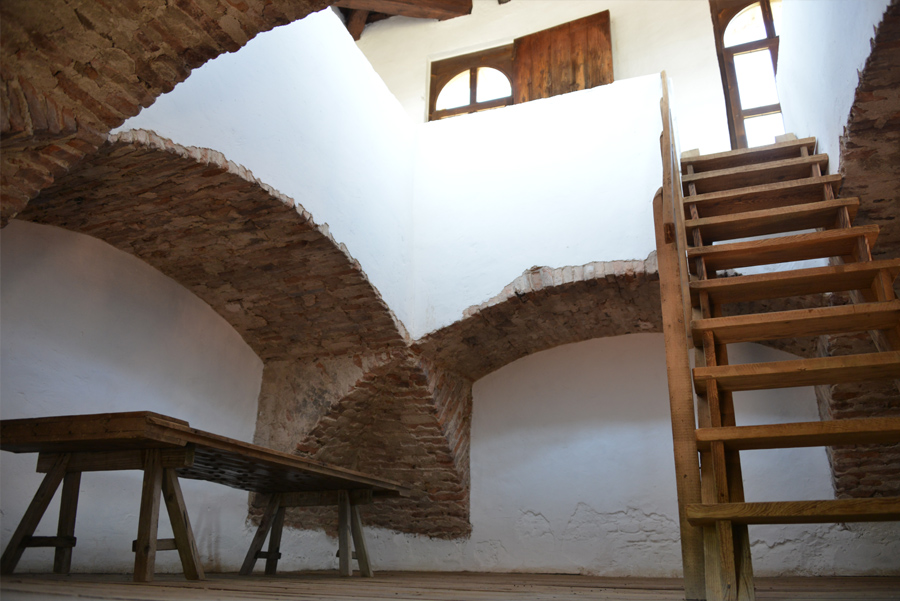
You can sit in the courtyard or outside and drink or eat something in the Tavern, whose floor in the first room is very old.


 -
Italiano
-
Italiano -
Deutsch
-
Deutsch